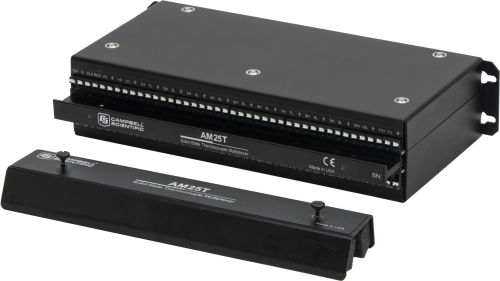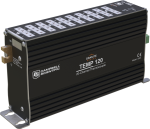
Several AM25Ts can connect
to one data logger






Visão Geral
The AM25T 25-Channel Solid State Multiplexer increases the number of thermocouples that you can measure using a Campbell Scientific data logger. The multiplexer interfaces with the data logger and adds terminals so that you can wire additional thermocouples or other low-level voltage output sensors.
Leia maisBenefícios e Características
- Greatly increases the number of thermocouples a data logger can measure
- Multiplexes up to 25 thermocouples
- Includes an on-board PRT that serves as a reference junction
- Allows several AM25Ts to be controlled by one data logger, increasing the number of thermocouples that can be measured
- Uses a metallic, internal ground plane to reduce thermal gradients, which ensures more accurate measurements
- Provides a vertical package for a smaller “footprint” that makes it easier to fit in a crowded enclosure
- Supports a maximum cable length of 152.4 m (500 ft) when lightning protection is used
imagens






3D / CAD Files:
Produtos Relacionados
Descrição Técnica
Up to 25 thermocouples are sequentially connected to a common differential channel on the AM25T. (Note: Other low-level voltage output sensors that do not exceed the common mode range of the data logger can also be measured. The AM25T should NOT be used to measure resistive bridges or configured with a voltage divider between the AM25T and the data logger; ask about our AM16/32B multiplexer for these applications.) The output from this channel is wired to a differential input channel on the data logger. As the AM25T sequentially changes channels, the data logger measures the output from each thermocouple in sequence.
A PRT attached to the AM25T’s grounding bar provides a temperature reference for the thermocouple measurements. The heat capacity of the grounding bar and an insulated aluminum cover reduce thermal gradients along the length of the multiplexer. Reducing the thermal gradients allow more accurate measurements.
Compatibilidade
Please note: The following shows notable compatibility information. It is not a comprehensive list of all compatible products.
Data Loggers
| Product | Compatible | Note |
|---|---|---|
| 21X (retired) | ||
| CR10 (retired) | ||
| CR1000 (retired) | ||
| CR1000X (retired) | ||
| CR10X (retired) | ||
| CR200X (retired) | ||
| CR206X (retired) | ||
| CR211X (retired) | ||
| CR216X (retired) | ||
| CR23X (retired) | ||
| CR295X (retired) | ||
| CR300 (retired) | ||
| CR3000 (retired) | ||
| CR310 | ||
| CR350 | ||
| CR500 (retired) | ||
| CR5000 (retired) | ||
| CR510 (retired) | ||
| CR6 | ||
| CR800 (retired) | ||
| CR850 (retired) | ||
| CR9000X (retired) |
Mounting Equipment
| Product | Compatible | Note |
|---|---|---|
| ENC10/12 | ||
| ENC10/12R | ||
| ENC12/14 | ||
| ENC14/16 | ||
| ENC16/18 | ||
| ENC24/30 | ||
| ENC24/30S |
Additional Compatibility Information
Sensors
The AM25T is typically used with type T, E, J, or K thermocouples; different thermocouple types are also supported (depends on data logger model and operating system). The AM25T can also measure other sensors that have a low-level voltage output. However, the AM25T should NOT be used with resistive bridges or be configured with a voltage divider between the AM25T and the data logger. The AM16/32B multiplexer is available for these applications.
Software/Programming
The AM25T is controlled by the AM25T instruction in CRBasic. When using Edlog, data logger Instruction 134 is used with recently shipped versions of the data loggers; older data loggers can measure and control the AM25T with a series of data logger instructions.
Short Cut software (available free of charge from our website) supports simple programming and generates wiring diagrams for AM25T applications; older versions of Short Cut did not support multiplexers.
Enclosure Considerations
The AM25T operates in most field conditions but requires a non-condensing environment. Outdoor applications require a weather-resistant enclosure augmented by desiccant; a Campbell Scientific enclosure is recommended.
Our ENC12/14 enclosure can house up to two AM25Ts, a CR800, CR850, CR10X, CR1000, or CR3000, and a power supply. The ENC16/18 houses several AM25Ts, a CR800, CR850, CR10X, CR1000, CR3000, or CR5000, and a power supply.
Especificações
| Expandability |
|
| Internal PRT Accuracy |
|
| Power | 9.6 to 16 Vdc (under load), unregulated |
| Typical Relay Resistance | 500 Ω |
| Maximum Switching Current | 25 mA (Switching currents greater than 25 mA will damage the relays and render them unusable.) |
| CE Compliance | Conforms to EN55022-1:1995 and EN50082-1:1992. |
| Operating Temperature Range | -40° to +85°C |
| Operating Humidity Range | 0 to 95% (non-condensing) |
| Dimensions | 23.6 x 5.1 x 13.2 cm (9.3 x 2 x 5.2 in.) |
| Weight | 0.9 kg (2.0 lb) |
Typical Current Drain |
|
| Quiescent | 0.5 mA |
| Active | 1.0 mA |
Enable Levels |
|
| Inactive | < 0.9 V |
| Active | 3.5 to 5 V |
Clock |
|
| Levels | Scan advance occurs on the falling edge of the clock pulse (from above 3.5 V to below 1.5 V) |
| Minimum ON Time | 50 µs |
| Minimum OFF Time | 60 μs |
Documentos Relacionados
Perguntas Frequentes Relacionadas
Number of FAQs related to AM25T: 9
Expandir todosRecolher todos
-
The AM25T was designed specifically to interface to Campbell Scientific data loggers only, with no provisions to interface to third-party devices.
-
The AM25T is typically used with thermocouples. It uses solid-state relays, which have a varying impedance from one closure to the next. This impedance is higher than the impedance in the mechanical relays used in the AM16/32-series multiplexer or the retired AM416 multiplexer. Bridge circuits (107/108 probes, PRTs, load cells, strain gages, and pressure transducers) should not be connected to the AM25T because of the varying and higher impedance values (compared to the AM16/32).
-
Programming the AM25T multiplexer might be considered more convenient because the newer data loggers have a built-in AM25T CRBasic instruction to handle both AM25T differential thermocouple measurements and differential voltage measurements. There is no CRBasic built-in instruction for the AM16/32B multiplexer. However, the newer versions of the Short Cut program builder software have AM16/32B compatibility for a variety of different sensor types.
-
The differences between the mechanical relays on the AM16/32B and the solid-state relays on the AM25T are noteworthy with regard to switching time, voltage and current levels, power consumption, and relay activation noise.
- Solid-state relays switch faster than mechanical relays. The solid-state relays on the AM25T have a maximum activation time of less than 1 ms, whereas the slower AM16/32B mechanical relays have a maximum activation of 20 ms. This is an important aspect to consider in high sample rate applications of a large number of channels.
- The mechanical relays on the AM16/32B multiplexer are rated for handling higher voltage and current levels than the solid-state relays on the AM25T.
- The power consumption for the mechanical relays on the AM16/32B multiplexer is significantly greater than that of the solid-state relays on the AM25T.
- The mechanical relays on the AM16/32B multiplexer make a distinct clicking sound when closing. In contrast, the solid-state relays on an AM25T are silent. The sound of mechanical relays may be annoying to humans or animals at the installation site. In some applications, the clicking sound of the relays can be a beneficial indicator that measurements are being performed.
-
The mechanical contact relays of the AM16/32B are subject to corrosion and pitting, which leads to increased relay resistance and greater variations of the resistance with each contact cycle. Switched currents in excess of 30 mA degrade the relay contacts involved, rendering the channel unsuitable for further low-level analog measurements. (If an AM16/32 relay has been used for currents greater than 30 mA, it is not suitable for low-level mV measurements.) The switching of higher level currents causes increased corrosion and pitting of the relays. The solid-state relays on the AM25T multiplexer are not subject to corrosion and pitting; therefore, they are more suitable for low-level mV signals.
-
The number of switched lines and banks is different between the two multiplexers. The AM16/32B multiplexer has the operating option of running 16 banks of 4 lines each or of running 32 banks of 2 lines each. The AM25T multiplexer has only the one operating mode of 25 banks of 2 lines each. The 4x16 and 2x32 modes of the AM16/32B can offer more channels, convenience, and flexibility in applications than the 2x25-only mode of the AM25T multiplexer can. The 4x16 operation mode of the AM16/32B is a significant advantage for resistive bridge measurements to switch the current to the bridge circuits in addition to lines set up for the bridge output voltage. The 2x32 mode of the AM16/32B and the 2x25 mode of the AM25T multiplexer are commonly used for sensors that require no excitation (that is, voltages and thermocouples). In the 2x32 mode, the AM16/32B multiplexer has seven more channels than the AM25T offers.
-
The AM25T multiplexer has a built-in PRT temperature bridge circuit for accurate thermocouple cold junction compensation. It also has heat stabilization features designed to minimize temperature gradients across the wiring panel. The AM25T incorporates a large amount of thermal mass in a central concentrated area around the wiring panel terminals. The wiring terminals on the AM25T are located close to each other and close to the heat stabilization mass.
On the AM16/32B multiplexer, the wiring panel terminals are spread out across a larger area and do not have the large thermal mass design around the terminals that the AM25T has. Part of the thermal mass includes a heat bar that runs under the wiring panel connectors of which the PRT reference element is coupled to. The PRT element is incorporated into a precision full bridge circuit and calibrated for accurate reference temperature readings. The AM16/32B multiplexer does not have a built-in reference temperature PRT and heat bar design. When using AM16/32B multiplexers for thermocouple measurements, an external reference temperature measurement will need to be provided.
Because of its built-in reference temperature circuit and thermal stabilization features, the AM25T multiplexer is more suitable for thermocouple measurements.
-
The mechanical relays on the AM16/32B are subject to wear and thus have a limited lifetime. The minimum life rating of the AM16/32B relays is 107 closures. For a relay cycle interval of 1 second, the minimum lifetime is three years. The solid-state relays on an AM25T don't have this issue.
-
The mechanical relays of the AM16/32B multiplexer are needed for switching excitation currents into resistive bridge measurement circuits. The solid-state relays of an AM25T multiplexer, in contrast, are not suitable for this. The switching relays on the AM16/32B multiplexer are mechanical and have an order of 0.1 ohm resistance. In contrast, the relays on the AM25T are solid state with an on resistance of approximately 500 ohm. The significant resistance of the solid-state relays is problematic for the precision excitation current needed for resistive bridge measurements.
Estudos de Caso
Intelligent Infrastructure Systems, a Pennoni company, was contracted to design and install an efficient structural-health......Leia mais
Imagine the bored mind of a space traveler as he looks around the room he......Leia mais
The 385-acre Chicago Botanic Garden welcomes more than 750,000 visitors each year. Its new Daniel......Leia mais




